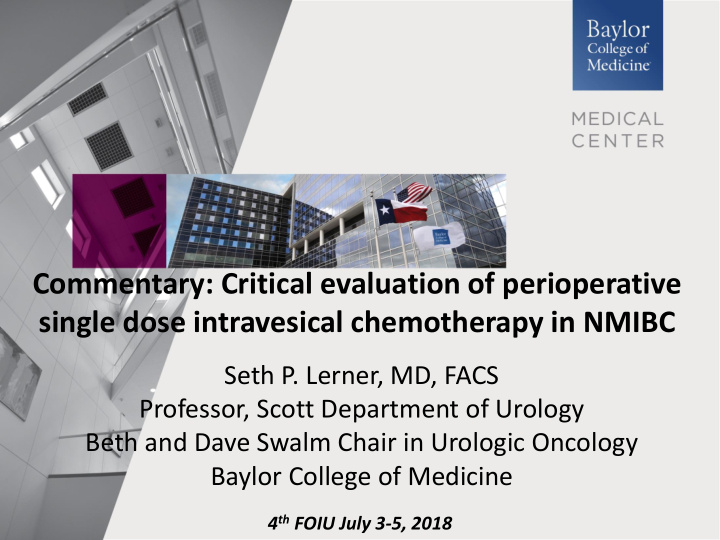



Commentary: Critical evaluation of perioperative single dose intravesical chemotherapy in NMIBC Seth P. Lerner, MD, FACS Professor, Scott Department of Urology Beth and Dave Swalm Chair in Urologic Oncology Baylor College of Medicine 4 th FOIU July 3-5, 2018
Financial and Other Disclosures Off-label use of drugs, devices, or other agents: MMC, Gemcitabine; regulatory agency,FDA, Data from IRB-approved human research is presented I have the following financial interests or Disclosure code relationships to disclose: FKD S Roche/Genentech S JBL S Viventia S BioCancell, Nucleix, QED, UroGen C UroGen, Vaxiion C 2
Risk Adapted Treatment • Low – peri-operative chemotherapy only • Intermediate – peri – op plus induction chemotherapy maintenance • High – peri-op plus induction BCG plus maintenance – Assess response with cysto, cytology, and biopsy (for CIS) • Very high – consider primary cystectomy
Post-TUR Drug Options Options: Mitomycin C 30-40 mg in 20-50cc Doxorubicin 40-50 mg in 50cc Epirubicin 80 mg in 50cc Gemcitabine 2gms in 100cc (SWOG 0337) • Retain x 1-2 hours • Options: – Treat in OR or PAR – Ideal to treat within first 6-24 hours post-TUR DO NOT DO in face of possible perforation NEVER use BCG post-TUR 4
Rare Toxicities Dystrophic calcification of the Ulcer in buccal mucosa bladder following Mitomycin C following cutaneous Gemcitabine absorption 5
Post-TUR Chemotherapy - Meta-analysis Sylvester, et al Eur Urol 69:231, 2016 6
Utilization and Judicious Use - USA • Survey of 259 US urologists 1 – 61% participated – 1010 eligible patients – 17% received peri-op instillation – 66% of urologists never used • Judicious use 2 – Prospective quality improvement collaborative – 2794 patients over 22 months/5 practice sites – Ideal use 38% to 35% after intervention – Judicious use 83 to 86% (appropriate use and non- use) 1 Cookson, et al J Urol 187:1571, 2012 2 Barocas, et al J Urol 190:2011-6, 2013 7
Utilization Peri-op CTX in Europe • 324 urologists surveyed (France, Germany, Italy, Spain, UK) – 55% participated – 954 TURBT in 771 patients – 43% received peri-op CTx – Factors associated with utilization • Country (UK highest, France lowest), fellowship trained, higher risk for recurrence, lower risk of progression, higher volume NMIBC treated Palou, et al World J Urol (2014) 32:525, 2014 8
Utilization Peri-op CTX in Canada • Similar issues regarding low utilization as USA • Cost MMC > Epirubicin so some centers using Epi preferentially • Logistic constraints in high throughput operating room and managing cytotoxic ctx • Small TaLG tumors often managed with office fulgeration • Most care provided by community urologists – Centralized care to academic center only in one region in Quebec Peter Black, Wassim Kasouf, personal communication 9
• Est 2-yr RR in control arm 60% • Powered to detect 45% RR in Gem arm • HR 1.53
Gem saves $170 M to $257 M compared with no instillation vs. $ 83 M compared with MMC Messing et al JAMA epub 4/30/18 Messing, et al AUA 2018
Summary – Peri-operative CTx • Low and intermediate risk TaLG most appropriate • Guidelines consistent in recommending use • Safety proven but rare severe toxicities with MMC • Utilization varies but increased from early reports – Geographic variation in utilization within US, Canada and Europe • Gemcitabine new standard of care – Less toxicity vs. MMC – Cost effective 12
Recommend
More recommend